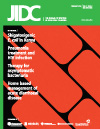Evaluation of “Cyscope”, a novel fluorescence-based microscopy technique for the detection of malaria
DOI:
https://doi.org/10.3855/jidc.2054Keywords:
malaria, fluorescence-based microscopy technique, diagnosis, resource-limited settingsAbstract
Introduction: This study was designed to compare the detection of malaria parasites in peripheral blood smears using the Cyscope malaria rapid fluorescent microscopic technique and light microscopy of Giemsa-stained smears.
Methodology: A total of 295 blood smears were collected from patients of all age groups presenting with clinical signs and symptoms of malaria to 10 City Health Clinics in Harare. For each patient two blood films were prepared. Microscopic examination was done independently in two laboratories, with one performing the Giemsa stain and the other the Cyscope method. After the tests were completed, the results were then matched and recorded without any alterations.
Results: An equal number of men and women were malaria positive and their ages ranged from five to 66 years. Concordance in the detection of parasites (positive or negative) was 98.6% (291/295). In all four cases of discordance, malaria parasites were detected using the Cyscope but not with conventional microscopy. The Cyscope gave a 100% sensitivity and a specificity of 98.6%.
Conclusion: The Cyscope may be a valuable addition to diagnostics of malaria in resource-limited settings such as Zimbabwe.
Downloads
Published
How to Cite
Issue
Section
License
Authors who publish with this journal agree to the following terms:
- Authors retain copyright and grant the journal right of first publication with the work simultaneously licensed under a Creative Commons Attribution License that allows others to share the work with an acknowledgement of the work's authorship and initial publication in this journal.
- Authors are able to enter into separate, additional contractual arrangements for the non-exclusive distribution of the journal's published version of the work (e.g., post it to an institutional repository or publish it in a book), with an acknowledgement of its initial publication in this journal.
- Authors are permitted and encouraged to post their work online (e.g., in institutional repositories or on their website) prior to and during the submission process, as it can lead to productive exchanges, as well as earlier and greater citation of published work (See The Effect of Open Access).








